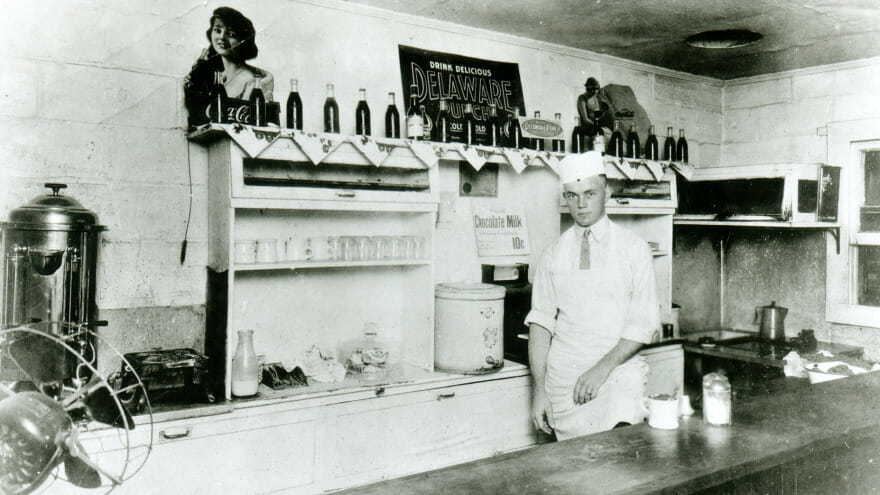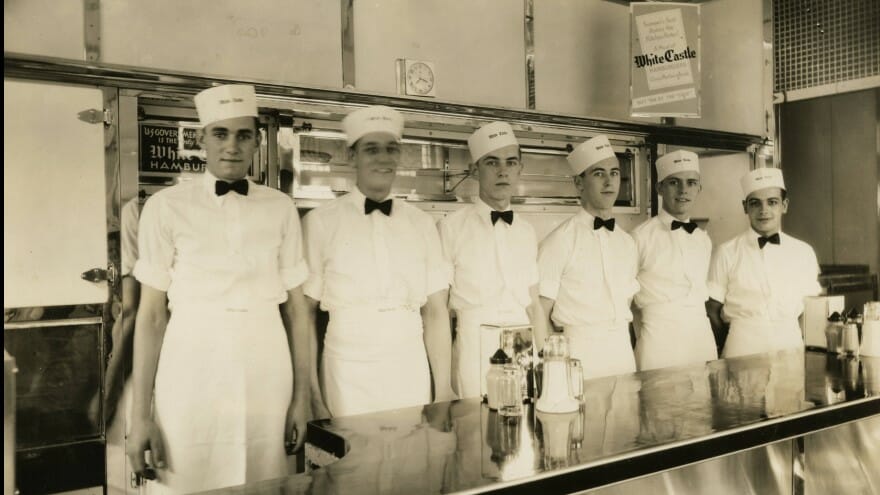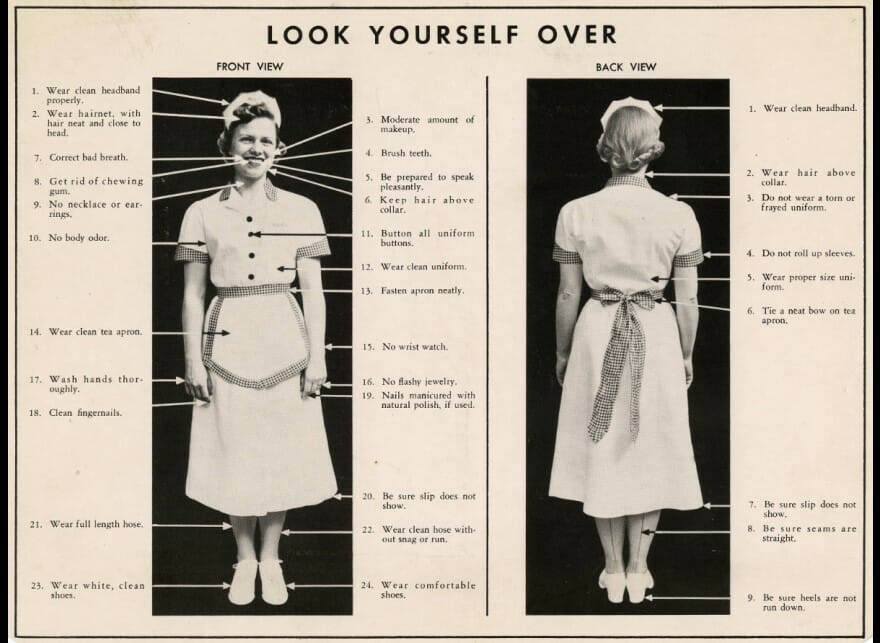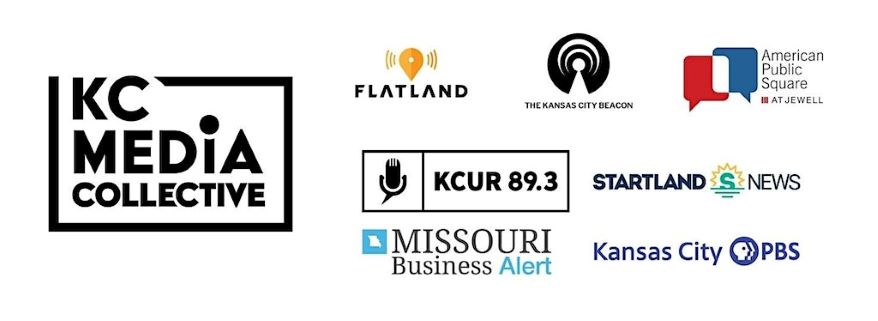White Castle Didn’t Just Invent Sliders. The Kansas Chain Created a Playbook for American Fast Food Wichita-based Chain Introduced America to the Hamburger
Published March 24th, 2023 at 6:00 AM
Above image credit: White Castle founders Walt Anderson and Billy Ingram stand next to two automobiles outside of White Castle number 10, located at 318 West Douglas Avenue in Wichita, Kansas. The sign on the building reads: "White Castle System, Inc. No. 10 - Hamburger - Buy 'em by the sack 5¢ Anderson and Ingram." Two employees can be seen posing in the window, which advertises "Good coffee 5¢ Cold drinks." (White Castle System, Inc. | Ohio History Connection)It may seem like America has always been obsessed with hamburgers. But here’s the thing: We actually used to be afraid of them. And the story of how we learned to not only trust, but love the burger starts with a fry cook in Wichita, Kansas.
J. Walter Anderson was born in Kansas in 1880 to Swedish immigrants. He was the kind of guy who never stayed in one place for too long, always on the lookout for his next big adventure.
For years, Anderson wandered around the Midwest — including a brief stint in show business — before getting a job in a Wichita diner.
It was there, as the legend goes, that Anderson created his version of the hamburger.
“There’s this one anecdote about how he was frying these meatballs,” says David Hogan, author of Selling ‘em by the Sack, White Castle and the Creation of American Food, “and he got frustrated and took this spatula and just slammed it down. Made it into a patty. And people liked it.”
To be clear, Anderson didn’t invent the hamburger. Technically, the combination of hot ground beef between two slices of bread first arrived in the U.S. in the late 1800s.
By flattening the patty and putting it in between two halves of a bun though, Anderson took a giant culinary leap forward; Hogan calls it the beginning of the “modern” burger.
“Prior to that, it had been essentially a meatball on a slice of bread,” Hogan says. “He put it between two halves of a bun, and now we have the food that we’re most familiar with.”
If you ate it now, you’d probably call it something else: a slider.

The Birth of America’s First Fast-food Chain
Anderson’s burgers were so popular that in 1916, he went out on his own, outfitting an old shoe repair stand with three stools and a sign: “Hamburgers, 5¢.”
He famously encouraged his customers to “buy ‘em by the sack” — which they did.

At the time, multiple things were converging in Wichita to create the perfect demographic for these unique sandwiches.
Wichita had been known as a “Cowtown” ever since cattle drives in the late 1800s, but starting in the early 1900s, it also became a place of innovation and industrialization. The combination of more people moving to cities in general — and the Kansas oil boom in particular — caused Wichita’s population to boom.
“The people who were eating the hamburgers initially were Walt Anderson’s factory worker clientele… They wanted something that was quick and savory and hardy and cheap, and that is exactly what these sliders provided,” says Adam Chandler, author of Drive-Thru Dreams, a Journey Through the Heart of America’s Fast-Food Kingdom.
According to the U.S. Census, Wichita had a whopping 72,000 residents by 1920.
That same year, Anderson expanded to four stands — and was being hailed as “King of the Hamburger” in The Wichita Eagle.
“Once a self-admitted Ne’er do well, a cook who came to Wichita less than a decade ago, learned that owners of big limousines have tastes for hamburgers and prefer to pay a nickel for them,” the article reads. “As a result the ‘Hamburger king’ resides in an imposing $12,000 home on the Hill.”
‘We’re Going to Stand Behind Our Product’
Historians believe that Anderson’s notoriety would have likely stayed within the confines of Wichita, though, if he hadn’t ultimately crossed paths with Edgar Waldo “Billy” Ingram.
“Billy Ingram is the ultimate 1920s booster, you know, those kinds of Machine Age industrialists just hustling nonstop to sell you something,” Chandler says.
Ingram saw promise in Anderson’s hamburger stands and wanted to turn them into a large-scale restaurant chain, the likes of which didn’t yet exist. But there was a big problem: Americans didn’t trust ground beef.
In 1906, journalist Upton Sinclair published “The Jungle,” a book highlighting the brutal treatment of animals, unsanitary conditions and poor working conditions at meat processing plants.
“It’s a book that takes the country by storm,” says Chandler. “We didn’t have a health code. We didn’t have an FDA. If you were dining out, you were taking a big risk.”
As a result, ground meat especially became seen as a legitimate health risk.
“Everybody who read it or head about it read instead that, oh my god, eating meat is bad — it’s dangerous,” Chandler says. “And there’s all kinds of stuff in the meat that you don’t want to eat.”

Anderson knew he was up against a strong stigma when he began his burger empire. He told The Wichita Eagle that kids would regularly pop into his stand to get half a dozen sliders to carry out, and he’d watch as they’d run around the corner to a fancy car where their mothers were waiting — too ashamed, he presumed, to come into Walt’s “dinky little place” themselves.
To combat these concerns, Anderson had fresh beef delivered twice a day and ground the meat in front of customers. But these initiatives were taken to new, slightly neurotic heights when Ingram joined the team.
Together, they doubled down on cleanliness and efficiency, so customers could feel comfortable and safe eating at burger joints.
The new concept debuted in March 1921: The White Castle System of Eating Houses. “White” to signify purity and “Castle” to signify strength and permanence.
“This was important because a lot of people thought that the hamburger industry was very fly-by-night,” Hogan says. “He wanted to show that, no, we’re here forever. We’re going to stand behind our product.”

Even today, White Castle sliders are a particular blend of culinary art and science. Just big enough to fit into the palm of your hand, the patties are square, so that every inch of space on the grill can be utilized.
Beginning in 1954, they started putting five holes in each patty to promote faster cooking. But the patties are no longer flipped — so they’re not grilled, per se, as much as steamed on a bed of onions, along with the buns, infusing everything with a very specific oniony flavor.
“It’s a very unique form of hamburger today,” Hogan says. “Certainly if you put them juxtaposed with other major hamburgers, the average consumer would not go for the White Castle. White Castle thrives where there is a very long, in many cases, a century-old tradition of White Castle.”
Ingram’s plan to convince America to eat hamburgers came down to promising them the same, perfect experience every time — so standardizing every part of the White Castle operation was key.
That started with the Castle building itself. Made out of white porcelain steel, they were shiny and easy to clean, and the restaurants all had the same open concept layout: a grill, a counter, and five stools.
Customers could watch as one of their “extremely positive” cooks quickly prepared their burger on the impeccably clean grill in front of them. Unlike restaurants nearby, the food was served pretty much instantaneously. The menu was small: burgers, coffee, Coca-Cola and pie.

“The funny thing is, today, if we had the exact same experience everywhere we go, we think of it as kind of weird and dystopian, right? But back then, that was a level of comfort,” says Chandler.
Something that set White Castle apart from other burger stands were the high standards they set for their employees, who were expected to be friendly and courteous. They had to wear clean white shirts, pants, and aprons. Hair was to be covered by a white cap, fingernails were to be kept neat and clean, and elaborate jewelry and wristwatches were strictly forbidden.
If you could make it through the mandatory two-week unpaid training period, it was a pretty good gig at the time.
“He’s paying them a good salary,” Hogan says. “He’s giving them health insurance long before it was a norm. He’s giving them retirement.”

This was especially impressive considering that by the mid-1920s, White Castle was expanding to a new city every few months: Omaha, Kansas City, St. Louis. They strategically built in industrial parts of cities and near college campuses.
Hogan says that, during a time when African Americans couldn’t travel safely around the country or freely enter most restaurants, White Castle was an outlier: “White Castles were known during the Great Migration as a place where African Americans could stop and get food.”
The company purchased a company plane so that Ingram and Anderson could regularly visit the new Castles and make sure they were up to snuff. Employees across the country stayed connected through a company newsletter called “The Hot Hamburger.”
In the early days, no one was doing what White Castle was doing.
The Henry Ford of Hamburgers
By the end of the 1920s, White Castle was even considered trendy. The chain had a stronghold in New York City, where it still enjoys a huge presence today.
“It literally was a craze,” Hogan says. “It was like, everybody just thought that this new product was so incredible.”

This new burger craze also reflected the bigger changes American culture was going through.
“I think there was something about what Billy Ingram was selling with the hamburger that made it seem modern, that made it seem like the culinary analog of the moment where he has this proto assembly line of people creating all these burgers… while, you know, a few hundred miles north, the assembly lines of Detroit are churning out Model Ts,” says Chandler.
To really make hamburgers an American icon though, White Castle had to move beyond their initial customers — and seduce the middle class.
So it worked to convince the public that its sliders weren’t just safe, they were nutritional.

The company commissioned a study at the University of Minnesota, where a medical student ate nothing but White Castle hamburgers and water for 13 weeks. At the end of the experiment, a food scientist came to the conclusion that a child could subsist off a totally White Castle diet and be perfectly fine.
“It was trying to convince young families, especially the moms who were in charge of the households back then, to feel comfortable serving these meals to their kids, and their family members,” says Chandler.
White Castle also hired an actress to play a fictitious spokesperson in the same vein as Betty Crocker, dubbing her “Julia Joyce, the White Castle hostess.” She’d go to women’s clubs and demonstrate White Castle products, showing how the hamburger could be the mainstay of the family meal.
By 1937, White Castle had managed to sell almost double the hamburgers it did in 1930 — and the president of the National Restaurant Association declared that the hamburger was as American as apple pie and coffee.
White Castle didn’t stop at mothers, either. In the 1950s — decades before the first Happy Meal was sold — Hogan says White Castle went directly after the children’s market, a population of 54 million youngsters, who accounted for about 40% of the country’s food consumption at the time.
Marketing studies suggested American mothers bought at least one item per week under pressure from their children — so White Castles across the country sponsored local TV shows, experimented with kiddie rides and installed better family-style seating.
“That became the centerpiece of White Castle’s marketing endeavors, and eventually fast food. The entire industry is kind of predicated on serving families,” says Chandler.
White Castle also became the first hamburger chain to advertise with coupons in the newspaper in 1933 — and their slider-carrying cartons were a revolutionary upgrade from the greasy fast food bags used by most chains.
“Billy Ingram did for the hamburger and eating what Henry Ford did for the car and transportation,” notes Hogan.

Burger Wars
White Castle was so successful that other entrepreneurs immediately started copying them. And these rival burger stands weren’t coy about it, copying White Castle’s playbook almost verbatim, starting with the name.
Here’s a sampling of the imitators that appeared: Royal Castle, White Tower, White Clock, Little Kastle, Little Palace, Little Crown, White Knight Nickel Sandwich, White Palace, White Log, White House, White Tavern, White Hut, White Fortress.
Some places just straight-up called themselves White Castle too.

“People in cities across America said, ‘OK, there’s something about this White Castle. We are not sure what it is. Let’s just copy the whole damn thing,’” says David Hogan.
The quality of these copycat operations was often questionable, but since many of them were housed in white buildings or featured castle architecture, they appeared extremely similar to White Castle. Some even had copycat slogans like “Take home a bagful.” Any reasonable customer would have been genuinely confused.
“It’s trademark infringement, obviously. A company is only as good as its name. When that name gets diluted, it’s a threat to their existence,” says Hogan.
The most shameless copycat was White Tower, started in Milwaukee, Wis., in 1926. White Tower set up in the same cities as White Castle and copied their architecture and strategy to a tee.
According to historian Marcia Chatelain, they even bribed a White Castle manager to steal the designs to White Castle’s “signature hamburger paddle” — in addition to accounting records and manuals.

Naturally, White Castle sued White Tower for unfair competition in 1929 and eventually won a payout of $82,000 — that’s equivalent of $1.2 million today. But not before White Tower sued them back, claiming that White Castle infringed on White Tower’s market when it expanded into Detroit after them.
The court ruled in favor of White Castle and required White Tower to refrain from using their similar name, slogans and building design. White Castle did not enforce the name change, but it did require White Tower to pay a royalty fee and send a photograph for each new location.
One of the most famous White Castle clones is still around today: Krystal, now headquartered in Georgia. One of Krystal’s co-founders admitted to visiting White Castle before opening Krystal in Tennessee in 1932, with the name intended to imply “clean as a crystal.”
Similar to White Castle, Krystal sells its small, square sliders by the “sackful.” (How similar the burgers taste today is a point of contention, but most customers say the biggest difference is that Krystal adds mustard.)
On top of these copycat chains, the case could be made that all fast food companies have lifted something from White Castle’s playbook.
“For a while, the success became such that you could go to a town and find a place selling small hamburgers in the 30s and 40s,” Chandler says. “And it wasn’t a surprise to you to find it because White Castle created that market.”
In 2014, Time magazine named the original White Castle slider the “Most Influential Burger of All Time.” In second place was McDonald’s, widely considered the most dominant American chain today.
But when it was started by the McDonald brothers in San Bernardino in the 1940s — two decades after White Castle’s start — McDonald’s bore some similarities to its predecessor: a limited menu, diligent levels of cleanliness, and a snappy tagline that encouraged people to “buy ’em by the bag.”

White Castle is widely considered America’s first fast-food chain, but Hogan thinks its legacy has been bulldozed in history because of McDonald’s, which became a household name after businessman Ray Kroc took the brand national in 1955.
“To believe the stories of Ray Kroc, he invented fast food,” Hogan says. “And of course, that is essentially the message that people get today — that McDonald’s was the revolutionary factor in the fast food industry. McDonald’s was a Johnny-come-lately! Ray Kroc, bless his heart, just learned somehow to do it bigger. And ultimately, I guess you could argue, better.”
Today, White Castle has less than 400 restaurants in the country. McDonald’s, thanks to its strategy of franchising, has more than 13,000 — and another 25,000 outside of the U.S.
“What White Castle really did in paving the way for brands like McDonald’s and all of its burgerly brethren is hard to match,” Chandler says. “It’s hard to understand. It’s hard to grasp. Because it came from virtually nothing.”
Why Did White Castle Leave Kansas?

There hasn’t been a White Castle in Wichita, where the restaurant chain got its start, since 1938. In fact, there hasn’t been a White Castle in the entire state of Kansas for decades.
The reason why lies in a series of changes that happened within the business during its second decade of life.
First was that Anderson let Ingram purchase his half of the company. Hogan says wanderlust had gotten the better of Anderson, who ended up instead dedicating himself to aviation, another big industry in Wichita.
Once Ingram was in complete control, he made another big change. He moved the company’s head office to Columbus, Ohio, which was more centrally located in their business territory.
While Ingram was nostalgic about those original Castles in Wichita, they weren’t actually doing as well as other cities — and no longer made financial sense to keep around.

His original plan was to sell off those first White Castle buildings to non-restaurants, so no one could capitalize on their brand. But then one of his longtime employees — Jimmie King, who moved to Ohio for the company and desperately wanted to return to Kansas — offered to buy four of the locations during a game of bridge.
Ingram accepted, under the condition that King changed the name and alter its distinctive architecture.
After rehiring most of the White Castle operators, Jimmie King dubbed the new burger stands Kings-X. (So, not a castle, but still in the royal family.)

Kings-X unofficially carried on the White Castle tradition in Wichita for another 74 years, until the last one closed in 2012 — that’s three times as long as Anderson’s own burger reign in Wichita.
The same thing happened as soon as White Castle started pulling out of the Kansas City metro in the late 1930s. Multiple operators went on to start their own hamburger chains: Wolf Burgers, Truman’s Hamburgers, Hayes Hamburgers, and perhaps most famously, Town Topic.
According to a 2015 Eater article, Town Topic is one of the “21 essential hamburgers of America.” They still have two locations in downtown Kansas City, down from a peak of six.
The mini-chain was started in 1937 by former White Castle employee Claude Sparks, who told The Kansas City Star that he “patterned it exactly after White Castle.”
Sparks’ descendants still make the burgers at Town Topic in a familiar way: by steam griddling the patty on top of thin shreds of raw onion.
All that’s to say, it’s hard to overstate the importance of White Castle in Kansas City — and in fast food history.
“I think in a universe where White Castle didn’t exist, you would still have the need for roadside food,” Chandler says. “I don’t know if it would look the exact same and I don’t know if it would be hamburgers.”

Embracing an Underdog Legacy
Today, White Castle only has a physical presence in 16 states, but it’s expanded in other ways — like into the grocery store. Sliders, chicken rings and breakfast are all available in the freezer aisle.
Unlike some of its larger competitors, White Castle is also still family-owned. Its current CEO is Lisa Ingram, the great-granddaughter of Billy Ingram.
“At the end of the day, we don’t try to be like everybody else,” says White Castle spokesperson Jamie Richardson. “We’re not trying to read someone else’s playbook. We’re just trying to write our own story.”

Although they no longer have a presence in Wichita, White Castle does pay homage to Anderson’s first, legendary burger with the “1921 slider.” A special press at every Castle is used to smash down a pre-portioned meatball to echo the historical origin story.
They’ve also held pop-up White Castle events in Wichita to celebrate milestone company birthdays. Most recently, they’ve offered to pay to transport a Kansas White Castle-style structure making the rounds on social media, should a museum or historical society want it.
The original White Castle location in Wichita has since been turned into a bank, but Chandler says dozens of people visit the location every month to take a picture of the memorial plaque and revel in the location’s claim to fast-food fame.
“To have this memorial to it and have it be something that people make a pilgrimage to, I think kind of shows it stood the test of time, even though there hasn’t been a White Castle in Kansas in many years,” he says.
You can see ghosts of White Castle in Kansas City, too. It returned to the metro area in 1985. (Some might rememberthere was a lot of drama over the Overland Park location, which city officials wanted to paint beige.)

While it stopped operating here for good in 2001, the second-ever location still stands at 7th St. and Grand Blvd. downtown. It’s just been turned into a barbershop.
When customers or passers-by ask the salon about it, employees proudly point to a historical photo of the original White Castle in all its glory.
“White Castle fandom stands out in large part because of how small White Castle is relative to a giant like McDonald’s,” Chandler says. “People are hungry… for a release, for an escape, for something that’s cheap and familiar and stands in for meaning in a lot of ways.”
That’s true whether you’re looking at the inductees to the Cravers Hall of Fame, fans of the 2004 cult classic “Harold and Kumar Go to White Castle,” or the 2,600 Facebook users dedicated to bringing White Castle back to the Kansas City area.

The beauty in fast food is that it always tastes and looks the same. Whether you’re on the road or in a new city, you’re able to get exactly the food you’re craving.
And that’s not an accident — it’s how Billy Ingram and Walt Anderson built it a century ago. A White Castle slider in New York was always supposed to taste the same in St. Louis.
It was from that ambitious idea that America’s entire fast-food kingdom spread — solidifying the hamburger as the national American meal.
“White Castle is the kind of underdog in this story,” says Chandler. “White Castle really doesn’t get credit for what it did to make the hamburger the American icon that it is today.”
This story first appeared on KCUR 89.3, a member of the KC Media Collective. This episode of A People’s History of Kansas City was reported, produced and mixed by Mackenzie Martin with editing by Gabe Rosenberg and Suzanne Hogan. For more stories like this one, subscribe to A People’s History of Kansas City on Apple Podcasts, Spotify or Stitcher.



